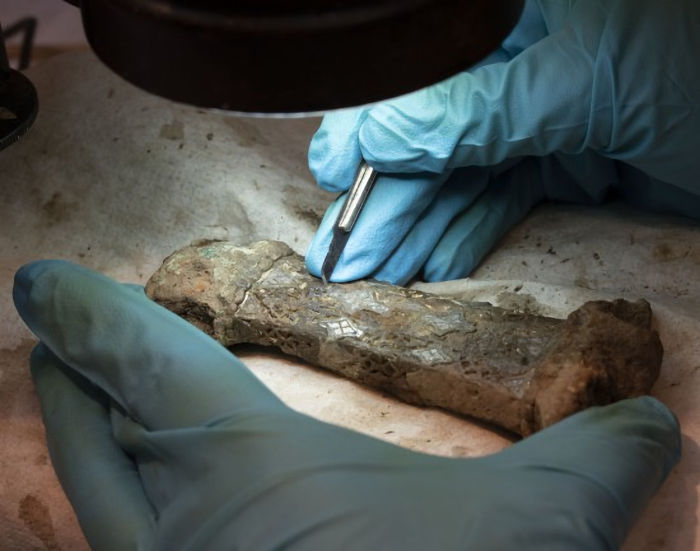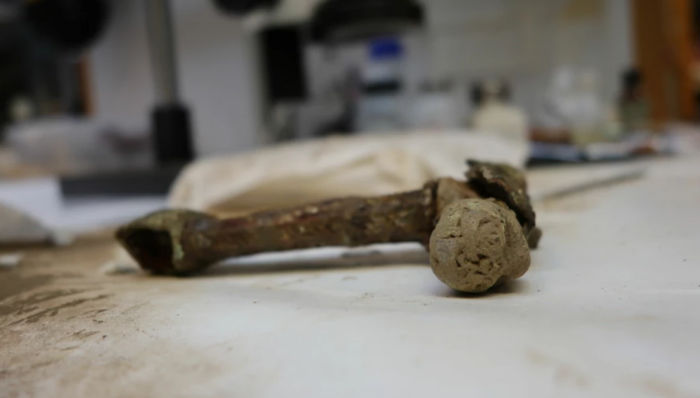Conny Waters – AncientPages.com – It happens every now and then that Viking swords are discovered but this finding is unique! As scientists ask – “What are the odds that two independent discoveries from the Viking Age fit together?”
The story began last year when a small part of a sword was first found on the neighboring farm where the “Gausel Queen” was buried at the time. The grave known as Gausel Queen’s is one of the richest graves in Norway.

Credit: Lise Chantrier Aasen, University of Stavanger
“According to Barbro Dahl of the Museum of Archaeology, the University of Stavanger, the Viking Age settlement of Gausel in Southwest Norway “gives an impression of wealthy women as owners of the farmsteads established in previous periods.”Gausel is an ancient farmstead that has been continuously occupied since pre-Roman times.
Lying on the west shore of the Gandsfjord, it was likely the most important steading in the area during the Viking age. At that time, many high-status burials were placed over ancient ruins, including ship graves and boat burials. These graves contain the highest concentration of Irish metal objects in the world.” 1
Scientists from the University of Stavanger report that this spring, an enthusiast from a detector club found large parts of a sword that turned out to belong alongside last year’s findings. The sword is so unusual that its reputation quickly spread within the academic community. The blade is missing, but the hilt has unique details in gold and silver, and exquisite details not previously known.

Both ends of the crossguard are formed as animal heads. Credit: Lise Chantrier Aasen, UiS
Archaeologist and expert on the Viking Age at the Archaeological Museum, Zanette Glørstad, has the following to say about the discovery:
“The sword is probably what we call a D-sword, i.e. one of the richest ornamented, and heaviest sword types of the Viking Age. Specimens have been found in both Eastern and Western Europe. In Norway, we have found about 20 pieces.
Many of the swords found in this country are probably imports, although we can imagine that replicas may also have been made by skilled swordsmiths in Norway. It is still difficult to see all the details of the Jåttås sword – but the décor includes elements of the typical animal style from the Early Iron Age, as well as geometric figures of silver with so-called niello technique – that is, a metal mixture was entered as black stripes in the silver.
The underside is decorated in the same way as the grip, and at each end, the halt is designed as an animal head. The décor may indicate that the sword was originally made in the Frankish Empire or England and that it dates to the early 9th century. The closest parallel we know is a sword from the Island of Eigg in Scotland, which was found in a 9th-century tomb.
The technique is of very high quality, and both the complicated décor and the special design make this undoubtedly an absolutely outstanding find, which will have great interest also for specialists from other parts of Europe. Now we are very much looking forward to seeing the sword fully preserved, and will then contact scientists abroad to bring more clarity into the origins and parallels of the sword.”
See also: More Archaeology News
“We knew that this area was of particular importance, but that we were going to find something like this was very unexpected! This is great to bring in just before the national ᴀssembly anniversary!” Håkon Reiersen, a researcher at the Museum of Archaeology in Stavanger said.
Just as the women buried in the Oseberg ship, the Gausel queen had taken a lot of rich artifacts from the British Iles with her in her grave.
“This find means that we have to take a new look at the entire Jåttå-Gausel area,” Reiersen added.
“The outstanding collection of imported spectacular finds connected to both men and women from the area shows us that this has been an important hub for the contact across the North Sea,” he said.
Both metal detector enthusiasts immediately turned in their finds to Cultural heritage management. This ensured that the Archaeology museum could take care of the two parts, and start their work on the conservation as well as a reconstruction.
At the moment, the sword is preserved at the Archaeological Museum, by conservator Cora Oschmann, and the sword will be exhibited at the Archaeological Museum when it is finished preserved.
Written by Conny Waters – AncientPages.com Staff Writer
Expand for references
- Johanna Wittenberg – Women Landowners In The Viking Age
- University of Stavanger





